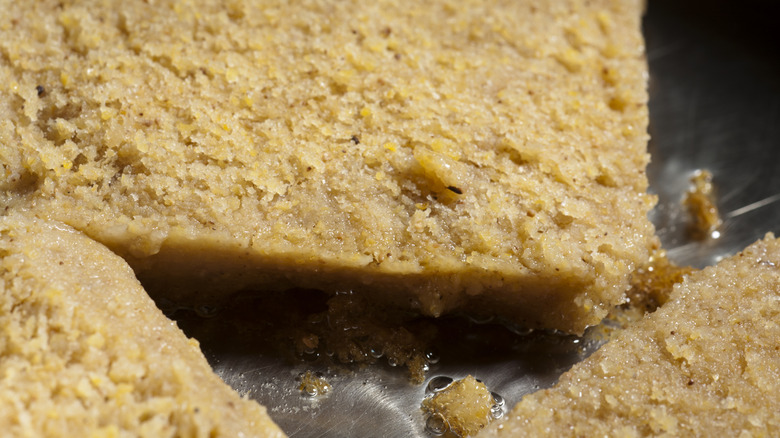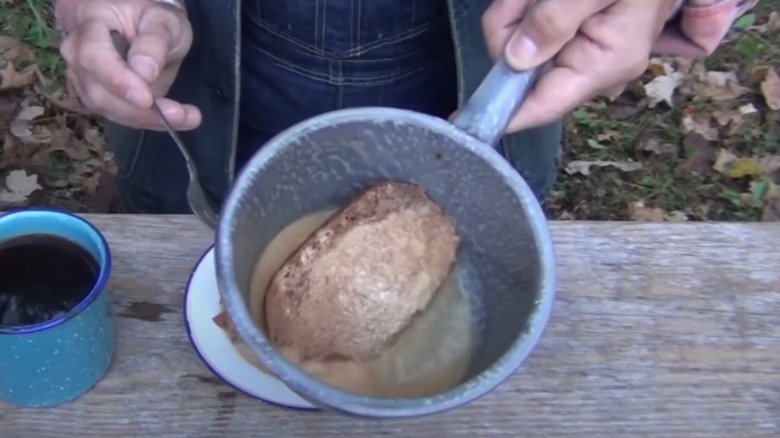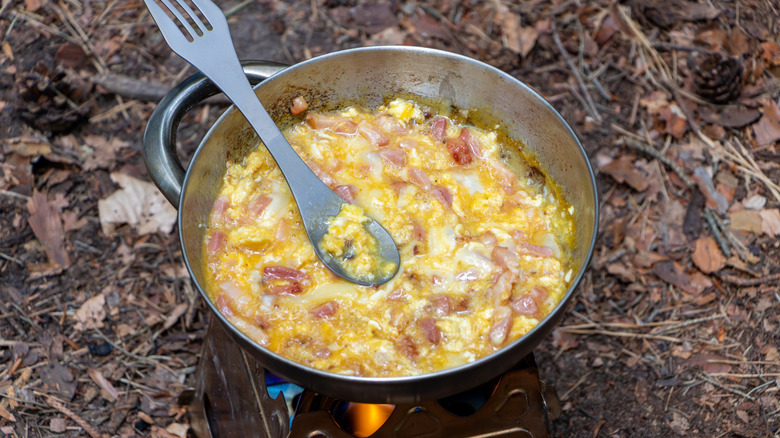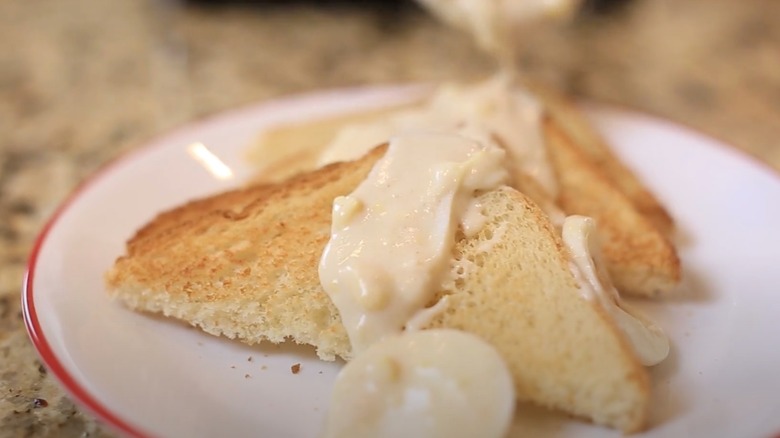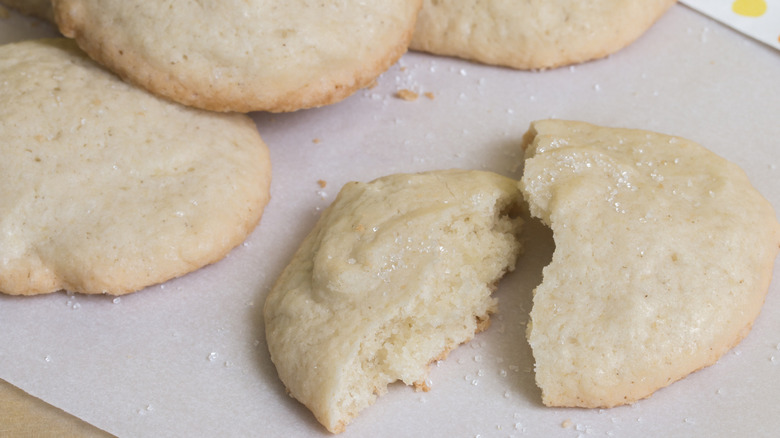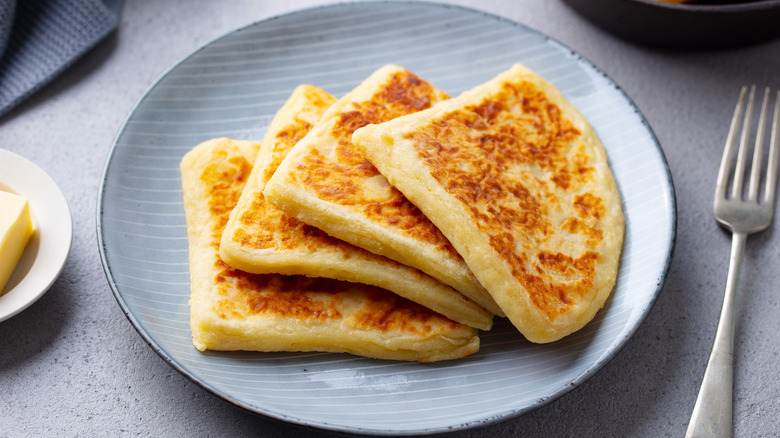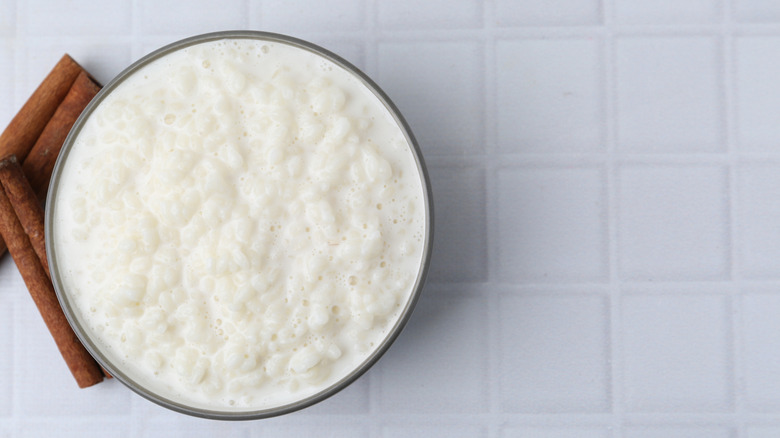Depression-Era Breakfasts No One Has Anymore
The history of food in a country is also the history of its economy. When countries are prosperous, it's reflected in the ingredients used in local cuisine and the size of its servings. When they're struggling, the meals people eat are often driven by resourcefulness and a need to make ends meet. The meals during the Great Depression were a great example of this in action. Food became harder to find, with items like meat becoming more scarce and canned ingredients taking on a more important role in households. When it came to breakfast, things were especially tight, and if people weren't skipping it entirely, they were cobbling things together from cheaper, often starch-based ingredients to fuel the day ahead.
While lots of foods we recognize were popular during the Depression, it's little surprise that Depression-era breakfasts have largely died out, considering how meager many of them were. However, looking at them is an interesting time machine to a moment in history that's now long gone. Dishes like coffee soup, creamed eggs on toast, and cornmeal mush are now no longer seen anywhere, whereas others like breakfast sugar cookies have lived on as snacks instead of full-on meals. Let's take a trip down memory lane, and examine what people ate first thing in the day during one of the hardest times in American history.
Cornmeal mush
There weren't a lot of foods that were plentiful during the Great Depression, but corn was one of them. As a result, both corn and cornmeal feature in a lot of recipes from the time, and the latter acts as the base for one of the most common breakfasts of the era. Cornmeal mush was exactly what it sounded like: A combination of cornmeal and water, mixed together and cooked until ready to eat. A pinch of salt could be added for flavor, and home cooks could also add in whatever additional ingredients they wanted (or had lying around), to make it taste better.
Cornmeal mush was often served as a kind of porridge, but it was also made into slightly less depressing forms. Some folks would form the mush into a loaf shape, before slicing it into planks and making fried mush with some butter. This gave it a crispy exterior while keeping the inside nice and soft. The light sweetness of the cornmeal mush would also pair well with any sugary ingredients cooks had to hand, like honey or molasses, which could serve as a topping. Hey, suddenly this breakfast doesn't sound so bad.
Coffee soup
The Great Depression was truly a time when families had to make do with what they had and make meals out of barely anything. Few dishes embody this spirit as much as coffee soup. This Depression-era dish was created by Amish communities in Pennsylvania, who were forced to be even more frugal than before when the economy took a turn for the worse. Coffee soup was born, and while it hasn't completely disappeared in Pennsylvania, you're unlikely to see anybody from younger generations making it, and it'll likely get even rarer as time goes on. Perhaps that's because coffee soup is the ultimate in making do.
This dish consists of black coffee mixed with half-and-half and sugar, which is then poured over slices of bread. If there's any lying around, cooks can then sprinkle some cinnamon or cinnamon sugar over the top. It's a breakfast with a kick, while just being essentially a cup of coffee on top of some bread pieces. It was, however, a great way to soften those stale ends of the loaf, and it also gave hungry farmers a jolt of caffeine with their breakfast, without having to make a separate drink.
Homestead breakfast
Not all breakfasts during the Great Depression were frugal and minimal. Some of them were as filling as anything you'd find today, without using complicated ingredients or taking ages to prepare. One of these breakfasts was the homestead breakfast, which essentially turned a few everyday staples into an elevated version of scrambled eggs. The recipe was simple: You cooked bacon in a pan until crisp, before adding in some onions and cooked, diced potatoes. Once everything was browned, you poured in some beaten eggs, and cooked everything until they set. Then you could heap it onto a plate and enjoy.
The beauty of this breakfast was its combination of ease and heartiness. It was ideal for folks looking to stock up on energy before a long day of work, and it brought everything together in one pan. While fresh meat was rarer during the Great Depression, kinds like bacon were slightly more plentiful thanks to their affordability, while eggs were in good supply for families who had access to hencoops (either in their own backyard, or a neighbor's). Meanwhile, potatoes were a staple, and one of the cheapest foods families could buy.
Milk toast
Milk toast is one of those dishes that sounds as depressing as the time it was most popular. At its most basic, this breakfast is a simple combination of the two foods it calls out in its name. Stale bread was combined with warm milk in a bowl, with the bread toasted on each side to increase its sturdiness. If you had it lying around, you could butter the toast on each side, and add a little salt and pepper for some more flavor.
No one gets any prizes for noticing that this dish is hardly exciting, let alone nutritious or filling. All the same, for cash-strapped families during the Depression, it provided some much-needed sustenance at the start of the day. However, it wasn't always made this way. By cooking the milk with flour and butter, cooks could make a thick roux that added a touch of luxury to the dish. Mixing in some cinnamon sugar provided a pop of comfort and some much-needed flavor. Milk toast's legacy stretches beyond the Depression as a dish that could be served as a "sickroom food" — a bland meal that was kind to the stomach and helped people recover from whatever ailed them. We're glad things have moved on slightly.
Crackers and milk
There are cost-saving meals, and then there's crackers and milk. This Depression breakfast is one of the most basic out there, and while we can imagine it's now viewed through a slightly nostalgic lens, there's no denying that it's a little bit bare. In case you hadn't figured it out yet, the name crackers and milk isn't a catchy title for a more complicated dish: It's literally just the two items put together. Saltine crackers were crumbled into a bowl, milk was poured on top, and that was that.
We guess that this isn't much different from making breakfast cereal with milk, but at least breakfast cereal is fortified with vitamins and minerals. Here, the crackers are little more than flour and salt. As such, we can't imagine there was much nutrition in this meal (although we guess you'd get some protein and fat from the milk). It wasn't all bad, though. Crackers and milk served as a simple base for other ingredients, and sometimes folks would jazz it up with sugar, cinnamon, and butter, to make it more interesting and give it a richer flavor.
Creamed eggs on toast
We have an image of Depression-era meals as being completely devoid of nutrition, and relying on the most basic of staples. While the latter might be true, the former definitely isn't. Plenty of Depression breakfasts were similar to the ones we eat today and provided enough fat and protein to keep folks satisfied for hours, and creamed eggs on toast are proof of this. This breakfast was like an amped-up version of scrambled eggs, but instead of getting its creaminess from cooking the eggs low and slow, it used white sauce to bind everything together. Rather than scrambling the eggs, they were hard-boiled, chopped up, and added to the sauce.
Like scrambled eggs, creamed eggs on toast worked as a starting point for any other ingredients or flavors that folks had lying around. Peas or green onions were commonly added from people's gardens, and folks who had access to it could add ham or bacon. Instead of toast, people would often use biscuits as a base. We've got to be honest, we're unsure why this breakfast died out — we think it still sounds pretty good today.
Breakfast sugar cookies
Cookies for breakfast! It's every kid's dream, right? Well, we're guessing that during the Great Depression, it might have felt a bit less glamorous, but it was a reality for a lot of folks at the time. Sugar cookies were generally reserved for the weekends, as they needed a few more ingredients than the more frugal weekday offerings like bread and coffee. Families would save up their eggs and sugar, and turn them into simple, homemade cookies that could be turned into any shape people wanted.
If you were expecting these cookies to look like the kind you'd find today, though, you might be disappointed. Sugar was a precious commodity, so it was used in limited quantities in the cookies. As these cookies didn't have any butter or oil in them, they were also more brittle and dry than the smooth, chewy kinds you'd find today. The cookies would be eaten with coffee, with liberal amounts of milk (or condensed milk) for the kids. Hey, it helped to dilute all that caffeine.
Potato griddle scones
Depression breakfasts were often heavily starch-based, with folks trying to find innovative ways to use up leftovers and combine them with dry ingredients. Out of this impulse came potato griddle scones, a Depression breakfast item that wouldn't look out of place next to a plate of bacon and eggs today (although we'd imagine that back in the day, they were the main event). Potato griddle scones were made by mixing leftover mashed potatoes with flour, eggs, milk, baking powder, and shortening. The mixture would make a thick batter, although care had to be taken not to make it too wet, as this would stop the scones from cooking on the griddle properly. The baking powder helped to stop them from turning into hockey pucks, while the shortening gave them a touch of smoothness.
The potato griddle scones were then thrown into a greased pan and fried on both sides until browned and crisp. A touch of salt gave them some flavor, but otherwise they served as a pretty neutral base (or as a slightly dull breakfast on their own). Regardless of their flavor, though, they had a weightiness to them that made them very filling.
Breakfast rice
When it comes to Depression breakfasts, you see a lot of versions of the same dish: Milk combined with some kind of carbohydrate or starch. Breakfast rice was yet another variation on this formula. It was a kind of rudimentary rice pudding, but instead of simmering it on the stove for a long time to thicken it up, it was made quickly. All it took to make it was tipping some leftover rice into a pot of milk, and simmering the two together until everything was warmed through. Then, it was poured into a bowl and served.
We think you'll agree that this was hardly the most appetizing of meals, but just like rice pudding, you could make it more interesting in a range of ways. The most common seems to be by adding sugar, cinnamon, and butter. We'd imagine you could also add savory ingredients to make a kind of congee. Like a lot of other Depression-era breakfasts, this one didn't offer much nutritional value, but it'd certainly give you a boost of energy in the morning (even if just for an hour or two).
Brains and eggs
Some Depression-era breakfasts we'd happily eat today, but others we're totally fine with leaving in the past. Brains and eggs fall into the latter category. Brains, particularly pork brains, were a valuable source of protein during the Great Depression, as well as in the pre-industrial era. Brains, as one of the more perishable proteins, would typically be eaten pretty soon after a pig was slaughtered, but the emergence of canned brains made them a pantry-friendly staple, especially when times were tight. Scrambled brains and eggs were a smart way to mix the unappealing protein in with something else, and to produce a hearty breakfast for cold winter mornings.
Brains were also used in other ways during the Great Depression, with creamed brains often served for dinner. Brains were combined with white sauce and peas, and then served over biscuits, with pastry, or with potatoes or rice. As time went on, the appeal of brains as a protein source died out, perhaps as other types of meat became more readily available.

